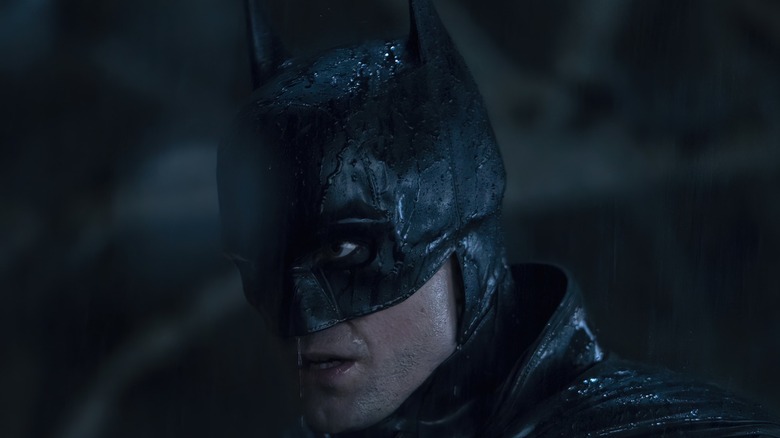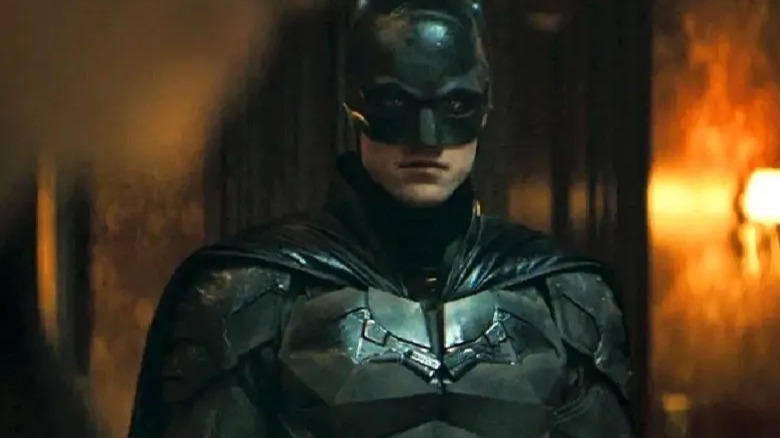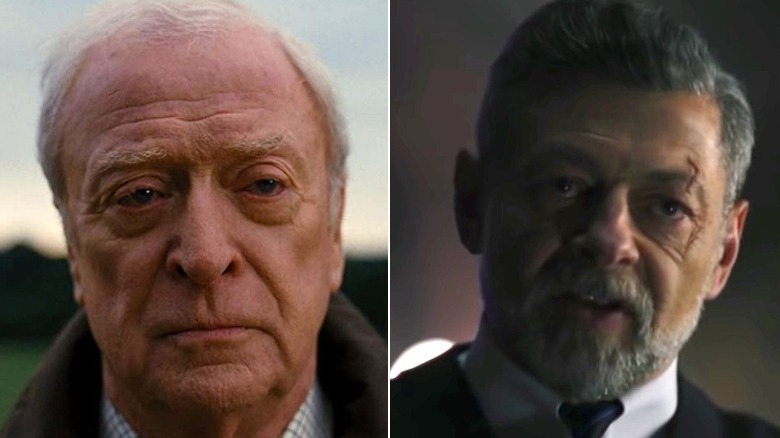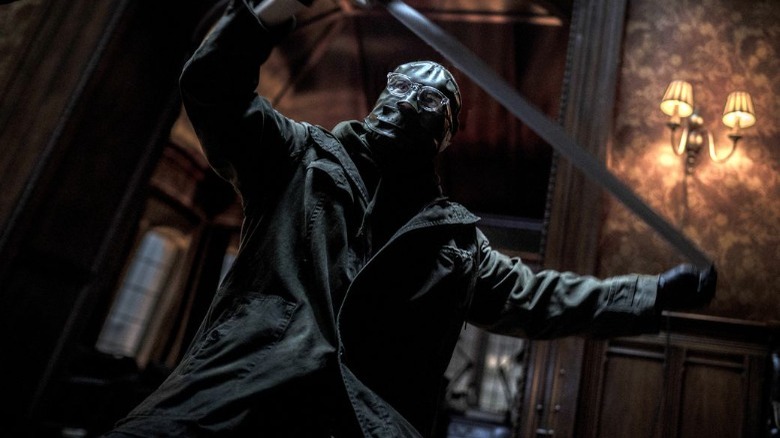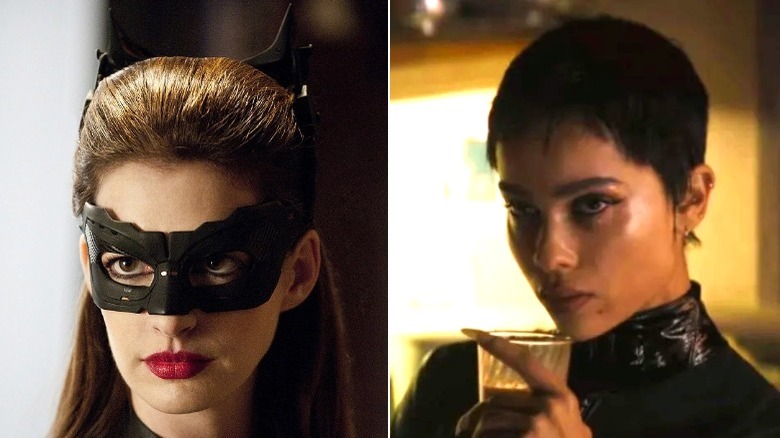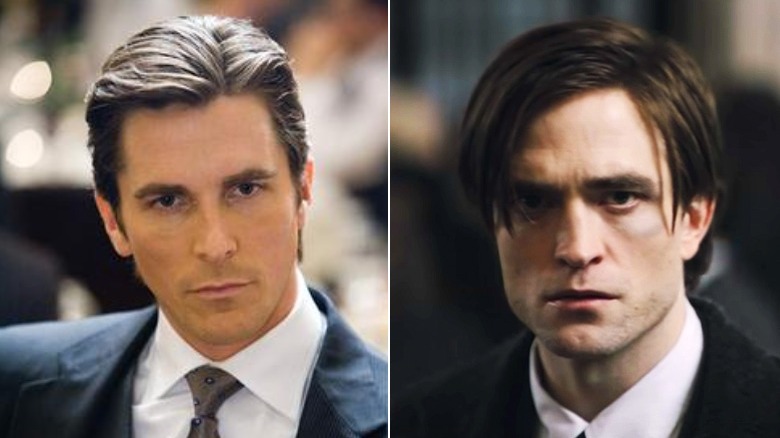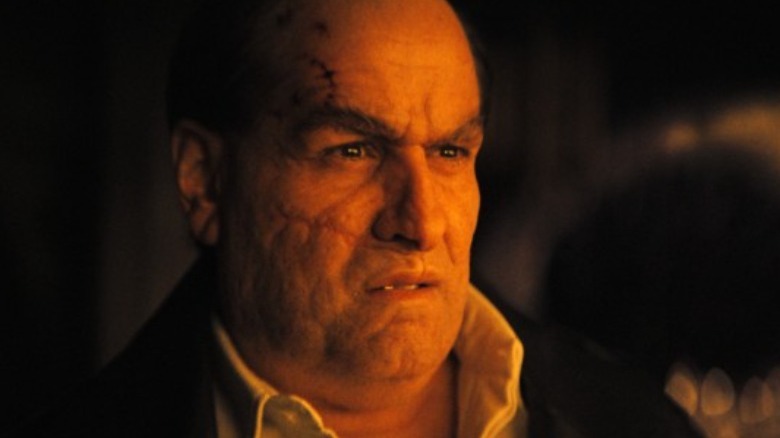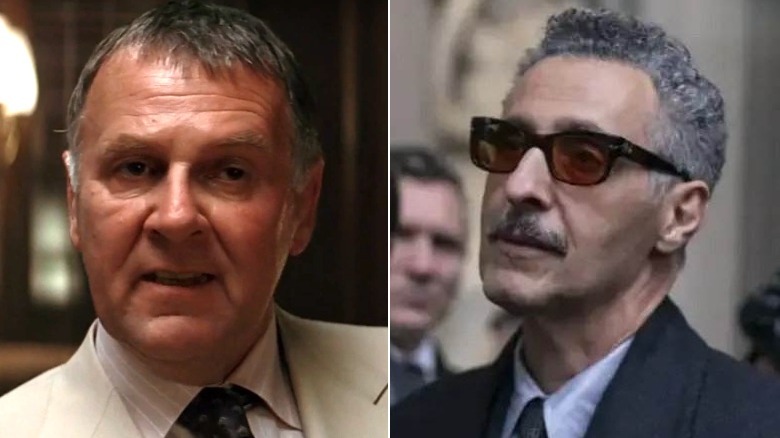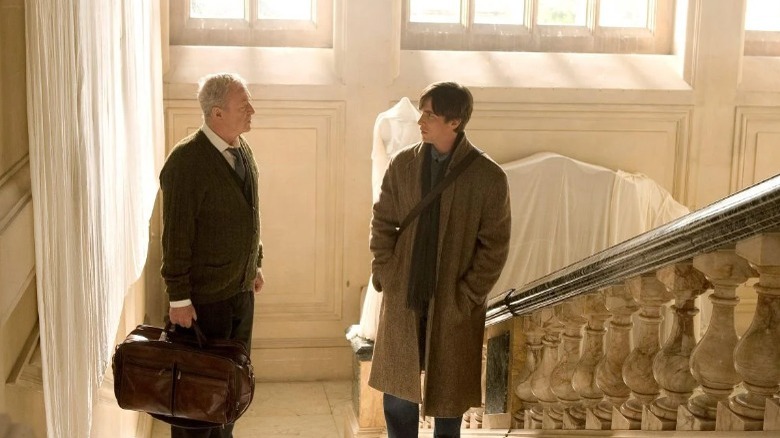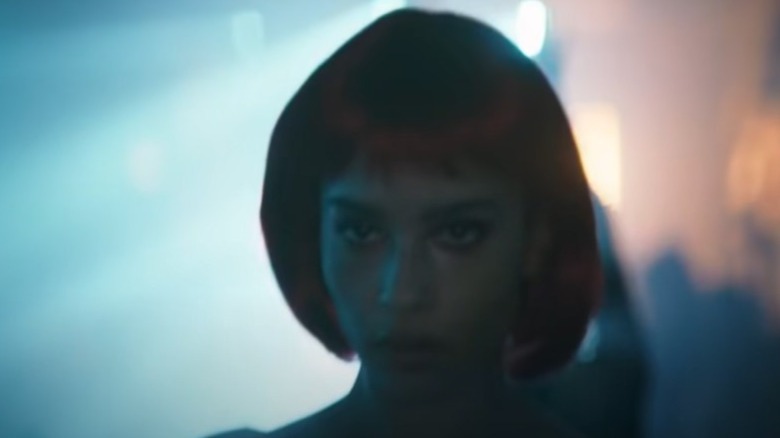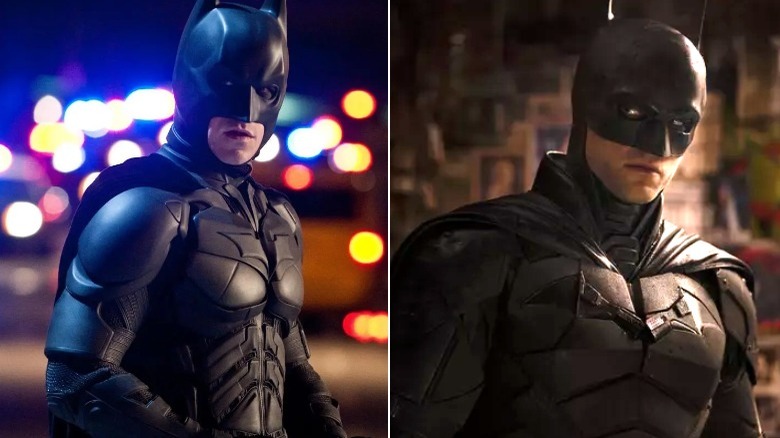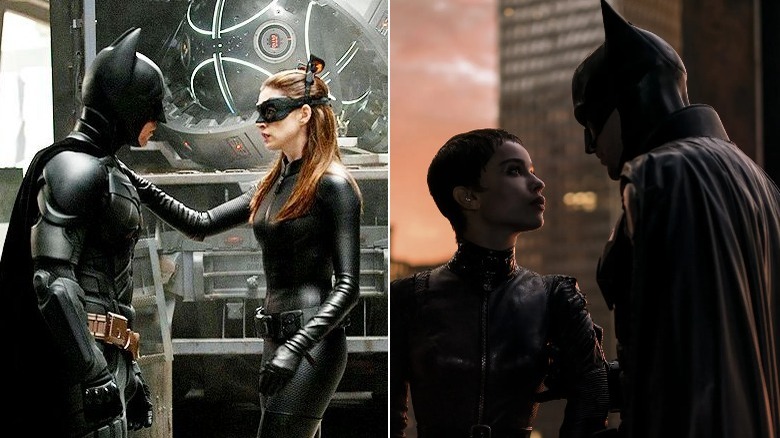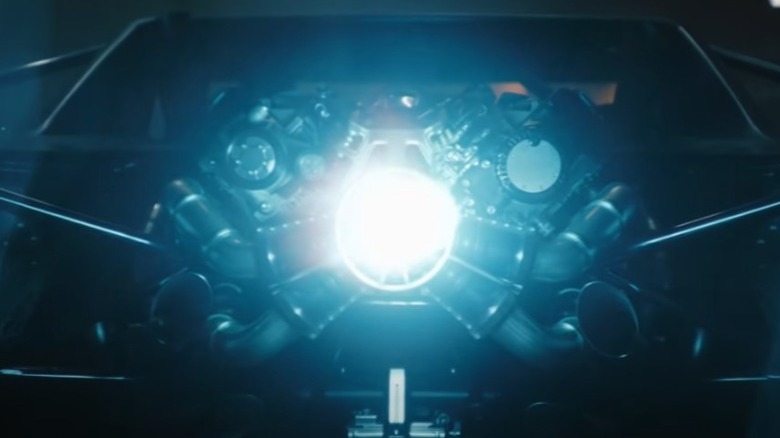The Biggest Differences Between The Batman And Nolan's Trilogy
Ever since 1989, gone were the days of the Adam West inspired "bright" knight iterations of the Batman. Each iteration of Batman brought him closer to his shadowy, noir comic book source material. Now, fast forward to 2005 with the release of Christopher Nolan's "Batman Begins." Nolan displaced any notions of comic book fantasy and treated fans with a more hard-and-fast real-world approach to the Dark Knight. Everything from Bruce Wayne's gear to his adversaries are far from fantastical. After enduring rigorous training at the hands of the League of Shadows, Bruce's prowess as a capable crime-fighter seems believable. His array of gadgetry, while fictional, were designed and written as if they could exist. Christopher Nolan ultimately asked the question: What if Batman were real? He then built an entire trilogy off the basis of that very query.
"The Batman" manages to expound on what its forbears did. However, it aims to define a Batman who must not only use his fists, but resort to his detective roots in order to save Gotham. "The Batman" and the Nolan trilogy, while both opting for a real-world darkened motif, are very dissimilar at the end of the day. Let's take a look at all the ways "The Batman" has found its own footing beyond the legacy of Nolan's trilogy.
Warning: this article contains spoilers for "The Batman."
Bruce became Batman without moving past his hatred
Both the Nolan trilogy and "The Batman" portrayed a Bruce Wayne who is consumed with his own hatred for the criminal element. In "Batman Begins," Bruce even goes as far as plotting the murder of his parent's killer in broad daylight by packing a revolver underneath his coat sleeve during the man's trial. The mob had Joe Chill killed on the steps of the courthouse before Bruce could do the deed himself. Regardless, he watched and savored the man's death. After a confrontation with Carmine Falcone, Bruce realizes he has to overcome his hatred and be better. He leaves town for several years to train, before returning to embark on his crusade as Batman, hoping to better Gotham City and bring the citizens hope.
"The Batman" presents an alternate picture of Bruce's entrance into the crime-fighting world. While he never resorted to killing, he clearly enjoyed brutalizing street thugs viciously. After two years, he finally starts to understand that being the Batman is actually a higher calling. It's a realization he comes to after seeing a far more warped mirror image of himself in the Riddler. Selina Kyle's very human struggle also helps encourage that transition in Batman's perspective. By the film's end, Batman resolves to bring hope to the people of Gotham. It's a strikingly different mission than simply hunting criminals to pound endlessly night after night.
Alfred takes responsibility for the Waynes' death
In "The Batman," Alfred Pennyworth is hospitalized after receiving a mail bomb from the Riddler that was meant for Bruce Wayne. When Bruce visits him, Alfred tells Bruce that he has to stop blaming himself for what happened to his parents. In fact, Alfred takes responsibility for their deaths by stating it was he who should have protected them. This alludes to the idea that Alfred is likely something of a bodyguard for the Waynes instead of a simple butler. Further evidence points to this fact when he reveals that he trained Bruce how to fight.
The Alfred of the Nolan trilogy wasn't a fighter, but he was a thinker. He offered Bruce sage advice in an effort to keep him from making fatal mistakes. It's Alfred who almost instantly understands Batman's adversaries like the Joker and Bane far better than Bruce. He's always analyzing and attempting to help Bruce get out of his own way.
One clear-cut similarity between both of the films is that both incarnations of Alfred have an abiding affection for Bruce Wayne as a semi-adoptive son. However, Michael Caine's version of the character ultimately wishes for Bruce to find a way to end his crusade. Perhaps Andy Serkis's iteration of the character may reach that point in the future.
The Riddler
The most obvious difference is none other than the primary villain of "The Batman." The Riddler never made an appearance in the "The Dark Knight" trilogy. The Riddler hasn't been see on the big screen since 1995's "Batman Forever" where Jim Carrey played the role of the brain-teasing wizard. However, the Riddler of "The Batman" poses a unique challenge for the Dark Knight, leading him along a trail of death and mystery. It's a crime procedural with Batman leading the charge. This neo-noir theme takes the Caped Crusader to a place we've never really seen him before in theatrical productions.
This version of the Riddler also plays heavily on horror imagery. Aside from the fear toxin of "Batman Begins," horror themes weren't nearly as pervasive in the Nolan trilogy as they are in "The Batman." However, the Scarecrow might be the most comparable villain in the Nolan trilogy to Paul Dano's Riddler. The similarity of using horror and fear tactics aside, Jonathan Crane is just as maniacal and unhinged as the Riddler. Though we don't get to learn anything about Crane's history explaining why he is the way he is, we do see that he relishes in his victims' demise. His fear toxin is something he is proud of, much like the Riddler is towards his plot to dismantle Gotham's most corrupt leaders.
Selina Kyle actually adopts the 'cat' iconography
Catwoman is famous for her fondness for all things feline. Her entire persona revolves around her skill as a cat-burglar, slinking her way past security to find the richest of rewards. Anne Hathaway's version of the character is that of a professional. By the time she enters Bruce Wayne's life, she's already led an entire career of theft and deception. However, she is never directly tied to the cat iconography that the character is famous for. Aside from a mask that is vaguely reminiscent of cat ears when her goggles are raised, Selina Kyle never embraces any cat-like motif reminiscent of her comic book counterpart.
Zoë Kravitz's portrayal of Selina Kyle is far more in line with the Catwoman persona we all know and love. She refers to herself as "the Cat" and even has cat-like nails capable of doing some nasty damage. When Batman enters Selina's abode, he mentions that she has a lot of cats. She replies that she has a thing for strays. The film isn't overbearing in its cat references — doing so would add a campy element that doesn't fit the gritty mold of "The Batman". However, this Selina Kyle embraces the persona just enough to be a more accurate depiction of the character than what the Nolan trilogy presented.
Bruce Wayne is a recluse from the get-go
Batman is who Bruce actually is as a person. Like Rachel Dawes indicated in "Batman Begins," his Bruce Wayne public persona is just a mask to hide his true nature. On the outside, Bruce often appears as a playboy who lives up the wealthy socialite life. That is most certainly the case in Nolan's trilogy. In "Batman Begins," he fraternizes with other elite figures in Gotham and is even seen flirting and swimming with two women in a water fountain. It's only after Bruce Wayne loses what he perceives as his chance for love and a normal life at the hands of the Joker that Bruce goes into recluse mode. For eight years, he removes himself from the public eye.
"The Batman" sees a Bruce who is already a recluse from the beginning. Perhaps it's hard to guess Bruce is a vigilante if no one ever really sees his face. When he finally steps out in the sun for the mayor's funeral, a startled press comments on his rare emergence. His temperament is not really all that different when he's wearing a cowl. He's sullen, overly serious, and contemplative. Unlike Nolan's version of the character, Batman is his sole focus.
The Penguin
Just like the Riddler, the Penguin is a welcome newcomer as far as Nolan Trilogy comparisons are concerned. The Penguin hasn't appeared on the big screen since 1992's "Batman Returns." Perhaps the most comparable villain in Nolan's trilogy would be Carmine Falcone as portrayed by Tom Wilkinson. They are both gangsters and Wilkinson's portrayal of Falcone is one of bullishness and haughty arrogance. Farrell's version on Oz (aka the Penguin), takes on a similar personality, constantly dismissing Batman's investigation with snide remarks.
Colin Farrell's transformation into Oz is Hollywood magic at its finest. Make-up, prosthetics, and Farrell's talent caused the actor to totally disappear into the role. While Tom Wilkinson didn't have to undergo any major transformations to become the clean-cut gangster that he is in "Batman Begins," he channels a very similar aesthetic and manner of speech. Wilkinson's Falcone points a gun directly at Bruce's face without any regard, and he doesn't hesitate to crack a nasty dig about Thomas Wayne's death. Oz is ruthless but also capable of slinging cutting wisecracks when the timing calls for it.
While both characters take up about the same amount of screen time between "Batman Begins" and "The Batman," we're destined to learn more about Farrell's Penguin with the upcoming HBO series. His scarred face and grungy exterior all elude to a story that's just waiting to be told.
Carmine Falcone is Selina Kyle's father
In the animated adaptation of "Batman: The Long Halloween," the story behind Carmine Falcone's war with law enforcement and Sal Maroni uncovered one interesting truth: Selina Kyle is Falcone's daughter. That said, the apple has fallen far from the tree. (The Jeph Loeb comic book storyline never addressed this connection, but it is hinted at in "Catwoman: When in Rome.") However, "The Batman" also uses this twist, ultimately giving Selina all the fuel she needs to commit patricide for her father's heinous deeds. Thankfully, the Batman is there to talk her out of making a potentially regrettable mistake.
The Nolan trilogy also took inspiration from several comic book storylines. In fact, elements of Jeph Loeb's "Long Halloween" were also used in "The Dark Knight." Primarily, the war against organized crime and Harvey Dent's disfigurement at the hands of the (Joker-run) mob were all elements loosely based on the comic. However, Selina Kyle's entrance into Batman's world in "The Dark Knight Rises" had zero connections with the Carmine Falcone we saw in the first film of the trilogy.
Wayne Manor is an orphanage before Batman begins operations
The Waynes' famous estate, Wayne Manor, often appears throughout Batman history as Bruce's decadent home on the outskirts of Gotham City. It's this very home that he was raised in and came of age eventually learning to fight crime. He made use of a cavern beneath the home's foundation and turned it into his base of operations. It's a tale as old as time, and one that Christopher Nolan's trilogy retreads in "Batman Begins."
However, "The Batman" doesn't depict Wayne Manor in the way that we're all used to. Instead of being Bruce's home, the reclusive billionaire lives in Wayne Tower. His Batcave is an abandoned subway station. Some might have been asking, where's Wayne Manor?
Later in the film, the Riddler reveals that Wayne Manor was essentially turned into an orphanage. It's the very orphanage that the Riddler grew up in as a young boy. Sadly, the building fell into disrepair — funding that was meant for the impoverished and displaced in Gotham was stolen by corporate and political crooks embedded in the City's leadership.
Wayne Manor does eventually become something of an orphanage in Nolan's trilogy at the tail end of "The Dark Knight Rises," when Bruce fakes his own death and retires from the crusade.
The Iceberg Lounge
Because the Penguin doesn't exist in the Nolan trilogy, neither does the infamous Iceberg Lounge. The two go hand-in-hand. As a favorite hang-out joint for the ruffians of the city, the Iceberg Lounge is ultimately one of the most iconic landmarks in the fictional world of Gotham. The Penguin is typically seen owning and operating the business as a front for his illegal and nefarious activities. Those looking for trouble know where to find it.
"The Dark Knight" briefly portrays a club setting where Sal Maroni and his goons seem to take a load off. However, that generic night club is the closest Nolan's iteration of Gotham City ever came to seeing something even slightly reminiscent of the famous Iceberg Lounge. Perhaps, there's something a bit cliché about big bads being holed up in dimly-lit dance clubs. Christian Bale's Batman seems very at ease with knowing where to find Sal Maroni surrounded by his goons.
Similarly to "The Dark Knight," the Caped Crusader in "The Batman" has no qualms about entering the criminal hive of the Iceberg Lounge and questioning perps. The somewhat exclusive club is one location Batman knows that he can usually find the Penguin. With Carmine Falcone out of the picture, the Iceberg Lounge will surely rise in prominence as the Penguin secures power for himself in the world of "The Batman."
Batman's suit his highly efficient for defense
As a one-man army waging war against crime, it's requisite that Batman enters the fray with a hefty bit of protection. Batman is surely going to be shot at from all angles. Since the Dark Knight doesn't employ the use of such weaponry himself, he must manage to keep his head on his shoulders, literally and figuratively. Batman's suit is often depicted as being outfitted with an armor plating capable of stopping most firearms. However, Nolan's trilogy went light on armor in favor of a trim, more agile Batman. In "The Dark Knight," Batman is attacked by dogs and even asks Lucius Fox if his new armor will repel dogs. Fox responds that while breathable, it might only repel a house cat. Therefore, this version of the character really has to get the drop on his enemies and approach engagements like a ninja.
"The Batman" goes in the opposite direction, packing on the armor to this version of the hero. The film goes to great lengths to depict a man who's still an amateur crime fighter and often makes mistakes. In Batman's line of work, mistakes can be fatal, so he needs all the help he can get. Seemingly, Batman's armor can withstand consistent fire from assault weapons, a shotgun blast to the chest, and even an improvised explosive device up close. There's no doubt that Robert Pattinson's version wouldn't have lasted long without this defensive build.
Batman and Catwoman's partnership has a different basis
Batman and Catwoman have a legendary relationship within the Batman mythos. While their relationship often leans on romance, it also suffers from the complexities of their diverging philosophies on crime. Nolan's depiction of their relationship is borne out of Selina Kyle trying to undercut Bruce Wayne over the terrorists taking the city hostage. She has nothing against him, but she's desperate to obtain the clean slate –- a seemingly mythical algorithm capable of erasing her records from every database in the world. Eventually, however, Batman's forgiving nature and determination to do what's right by Gotham inspires Selina to do the same.
Matt Reeves presents a Selina Kyle who's scraping by the best way she knows how. She steals from the wicked clientele of the Iceberg Lounge. Ultimately, she latches on to Batman in hopes that he'll help her track down a friend of hers who went missing. Their goals align, but only briefly. Once Batman uncovers more in the evolving Riddler case, he moves in a different direction. Ultimately, Selina helps convince Batman of the very real need for a true-blue hero in Gotham. While she has little hope for the city, her experience (coupled with the Riddler's) helps Batman understand the reality of the human lives affected by greed. Seeing them come to each other's aid in the final moments of the film is all we need to know about the connection between these two.
Simply put, Kravtiz's Catwoman is bent on revenge, while Hathaway's Selina Kyle fights out of a desperation for her freedom.
The Batmobile isn't a tank
Batman wouldn't be Batman without his iconic ride. The Batmobile often sets the tone for the type of Batman film we're about to watch. Nolan's trilogy presented a character who is ultimately at war with the criminals of Gotham. As such, he's equipped with a tank-like machine to intimidate his foes. The Tumbler (aka the Batmobile) was developed for military use, giving it the maneuverability and defensive measures Batman needs to do his work. The machine had a desert camo exterior before being painted black. For all intents and purposes, this machine was built for its functionality, not necessarily speed.
"The Batman" is a film that puts Bruce's anger on full display. It's all in his nickname uttered by several characters throughout the film: Vengeance. His Batmobile channels the vigilante's aggression with a muscle car design comparable to the classic Plymouth Barracuda. Unlike Nolan's machine, the entire visual of this classic muscle car design speaks volume about its tread-burning capabilities on the road. The slick steel frame and monstrous engine communicate that the driver means business. Hearing the thunderous roar of this jacked hot rod screaming onto the scene matches its driver almost perfectly. Vengeance is the game, and what better way to play than with a machine that figuratively and literally comes streaking out of the fires of Hell demanding penance?
